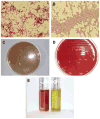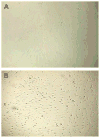Clostridium difficile
- PMID: 20513554
- PMCID: PMC5501328
- DOI: 10.1016/j.cll.2010.04.001
Clostridium difficile
Abstract
Clostridium difficile has re-emerged as a major hospital-acquired infection since 2001. Despite development of polymerase chain reaction-based testing, no single clinical diagnostic test has emerged with sufficient sensitivity, specificity, and turnaround time to be entirely reliable for disease diagnosis. The importance of C difficile acquired outside the hospital environment remains an unknown factor and awaits further epidemiologic investigation. This article discusses the changing epidemiology, clinical presentation, and pathogenesis of C difficile infection and highlights the ongoing challenges of laboratory diagnosis, treatment, and disease relapse.
2010 Elsevier Inc. All rights reserved.
Figures


References
-
- Hall I, O’Toole E. Intestinal flora in newborn infants with a description of a new pathogenic anaerobe, Bacillus difficilis. Am J Dis Child. 1935;49:390–402.
-
- Bartlett JG, Chang TW, Gurwith M, et al. Antibiotic-associated pseudo-membranous colitis due to toxin-producing clostridia. N Engl J Med. 1978;298(10):531–534. - PubMed
-
- Bartlett JG, Onderdonk AB, Cisneros RL, et al. Clindamycin-associated colitis due to a toxin-producing species of Clostridium in hamsters. J Infect Dis. 1977;136(5):701–705. - PubMed
-
- Jump RL, Pultz MJ, Donskey CJ. Vegetative Clostridium difficile survives in room air on moist surfaces and in gastric contents with reduced acidity: a potential mechanism to explain the association between proton pump inhibitors and C. difficile-associated diarrhea? Antimicrob Agents Chemother. 2007;51(8):2883–2887. - PMC - PubMed
Publication types
MeSH terms
Grants and funding
LinkOut - more resources
Full Text Sources
Other Literature Sources
Molecular Biology Databases

